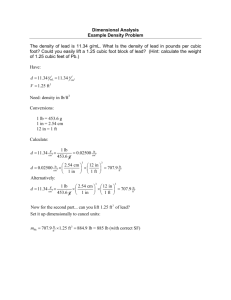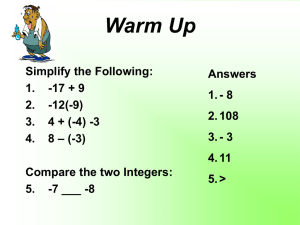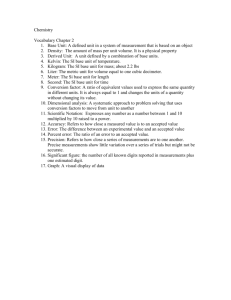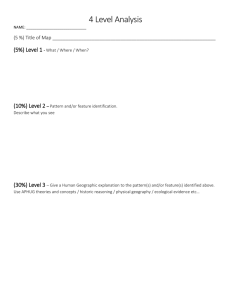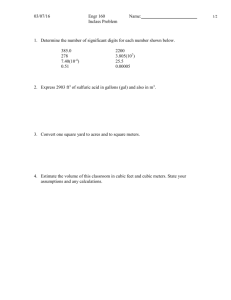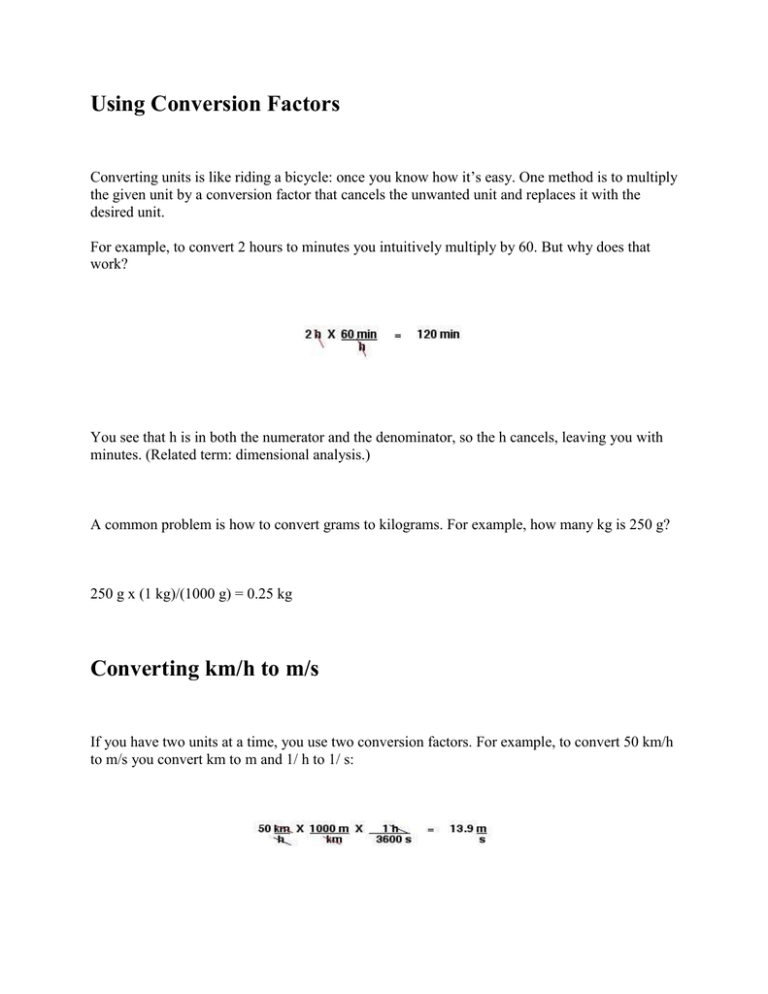
Using Conversion Factors
Converting units is like riding a bicycle: once you know how it’s easy. One method is to multiply
the given unit by a conversion factor that cancels the unwanted unit and replaces it with the
desired unit.
For example, to convert 2 hours to minutes you intuitively multiply by 60. But why does that
work?
You see that h is in both the numerator and the denominator, so the h cancels, leaving you with
minutes. (Related term: dimensional analysis.)
A common problem is how to convert grams to kilograms. For example, how many kg is 250 g?
250 g x (1 kg)/(1000 g) = 0.25 kg
Converting km/h to m/s
If you have two units at a time, you use two conversion factors. For example, to convert 50 km/h
to m/s you convert km to m and 1/ h to 1/ s:
Converting three units at a time, requires you use three conversion factors. For example, to
convert 50 mi/h to m/s you convert mi to km, km to m and 1/ h to 1/ s:
Converting mph to m/s
To convert miles per hour to m/s, we recall that there are 1.61 km in a mile, 1000 m in a km, and
3600 seconds in an hour:
60.6 mph * (1.61 km/mi)(1000m/km)(1h/3600s) = 60.6 * (.447) =27.1 m/s
6. Verify Units
Sometimes your professor will test your unit conversion skills. That isn’t without a purpose – in
physics (and science in general), units are crucial. You have to make sure your units are the same
throughout the exercise, otherwise formulas will not work. If you multiply velocity by time, you
will get the distance (assuming constant acceleration), but if the car moved at 10 km per hour for
5 minutes, multiplying 10 by 5 will not give you the right answer. Rather, you will need to either
convert the kilometers per hour to kilometers per minute, or (and probably easier) convert 5
minutes to units of hours.
The best way to do this is by fractions, but there are enough unit conversion guides out there that
explain this concept. Remember not to panic, do it carefully and you will get your correct values.
If we continue our example from the last part, we should convert the t(final) from minutes to
hours. This isn’t too hard to do:
(See how the ‘minutes’ units are canceled with the ‘minutes’ units in the denominator, leaving the ‘hour’ units with
the final answer? that’s a great way to check that your conversion is right)
Now that all your variables are in the correct units, you can continue solving the question.
Solving Dive Physics Problems
by
Larry "Harris" Taylor, Ph.D.
This material is copyrighted and the author retains all rights. This article is made available as a
service to the diving community by the author and may be distributed for any non-commercial or
Not-For-Profit use.
All rights reserved.
Go To Site Page: Home About "Harris" Articles War Stories
Editorials Links Site Map Fini
Biblios
Long ago it was said, "If you can't measure it, it ain't science!" Science may be thought of as a method of
quantifying our environment. Numbers and units are the prime means of communicating scientific
information. A MEASUREMENT IS INCOMPLETE WITHOUT ITS UNITS! For example, if someone asks
the distance to the nearest dive store and they are told, "It is two," there is information missing, i.e., does
the inquisitive diver have to walk two yards, two meters, two blocks, or two kilometers to reach the
nearest dive store? The point is do not separate measurements from their units.
In the numeric solutions to problems in this chapter, units are always present. If you wish, you can use
units to verify the technique of solving the problem. If you are uncertain whether the conversions you
have chosen are appropriate, look at the units; if your solution has the wrong units (i.e., the answer you
get is in inches and you are calculating a temperature), then most likely an error has been made. A
numeric solution cannot be correct without the correct units. In addition, examination of units may provide
a key to determining a numeric solution. There are many equations in physics, and often one forgets how
"numbers" or "conversion factors" are used to calculate the solution. Examination of the units of the
quantities involved can help develop a mathematical procedure to solve the problem.
EXAMPLE: In discussing use of lift bags, it will be necessary to calculate underwater weight of an object
to be lifted. This type of calculation uses the mass and density of the object (found in reference tables) to
determine the object's volume. But suppose you forgot the equation and could not remember whether
volume was found by dividing or multiplying the mass by the density. For example, you notice that the
units listed in the density table for salt water (64 lbs/ft3) were pounds (a unit of mass) per cubic foot (a unit
of volume). Thus:
unit of mass (lbs) / unit of volume (ft3) = a unit of density (lbs/ft3)
This reminds you that to find density you divide mass by the volume. Rearranging, the volume of the
object lifted is found by dividing the mass by the density.
unit of mass (lbs)
/ density (lbs/ft3) = unit of volume (ft3)
Although this is a trivial example, the principle of using units to aid in numeric solutions is universal. The
more complex the formula, the more helpful units will be.
EXAMPLE: The "number" used to convert liters and cubic feet is 28.316. Now, if you have a choice of
purchasing a 14 cubic foot pony bottle or a 400 liter pony bottle for the same price, which is the better
buy? Do you multiply or divide 14 or 400 by 28.316 to determine which cylinder provides more volume for
the same money?
ANSWER: Examine the units. The units of volume for the pony bottle are cubic feet (14 ft 3) or liters (400
l). The conversion factor is 28.316 liters/cubic foot. Set up the units in a linear string so that units "cancel"
to give the units needed in the solution:
14 ft3
x
28.316 l = 396.4 l
1 ft3
To convert from liters to cubic feet, "invert" the units:
400 l x
1 ft3 = 14.1 ft3
28.316 l
Since the 400 l cylinder contains more available air for the same money, in this example, it is the better
bargain!
NOTE: The ability to "invert" means that only one conversion "number" with its units need be committed
to memory. In this case, conversion from liters to cubic feet was accomplished by inverting the cubic feet
to liter conversion factor. An alternative would be to use the 0.0353 cubic feet/l conversion factor. (Divide
1 by 28.316; the result is 0.0353). Divers must decide which conversion factor is easiest for them to use.
It has been said that the exact definition of a problem is 90% of the solution. Working the problems in dive
physics (and in real life) will be easier if the same format is always used. The format that historically has
made learning easier and quicker is the following:
1. Determine from reading the problem: what is known, what is not known, and if there is a relationship
that will allow the determination of unknown values from known values.
2. Define the problem (write the equations or principles to be used in obtaining the solution).
3. Substitute the known values, with their units, into the equation, and finally,
4. Solve the problem (do the arithmetic!).
BOTTOM LINE: Using units at every step increases understanding of the problem AND increases
likelihood of obtaining the correct solution!
Importance Of Using Units
The procedures used to solve diving physics problems are the same in either English or metric units.
Physical principles are independent of the units employed. However, since the numeric values will differ
(since English units are NOT exactly identical to metric units), it is important to pay attention to the units
and use the SAME UNITS for temperature, pressure, volume, etc. during the entire calculation. For
example, if using depth in fsw, then atmospheric pressure MUST BE defined in terms of fsw. Ignoring
units can lead to problems. For example, there is a classic formula in the United States:
Absolute Pressure = (Depth / 33 ) + 1
This formula IS ONLY VALID when diving in sea water at sea level with depth measured in feet of sea
water to determine pressure in absolute atmospheres.. Using measurements in other units will give rise to
problems and potential unsafe environments.
BAD EXAMPLE: Assume an American trained diver on vacation rents a dive gauge calibrated in meters.
The diver (used to larger numbers from a gauge calibrated in fsw) dives with a guide to 40 m. If the
American diver only remembers D/33 + 1 (without units) the following diver calculation error is possible:
(Actual units the diver is using in {})
Absolute Pressure = ( 40 {m} / 33 fsw/atm) + 1 atm = 2.21 {m-atm / fsw}
SHOULD BE:
Absolute Pressure = ( 40 m / 10.1 msw/atm) + 1 atm = 4.96 ata
COMMENT: If only the "numbers" are used, there is a chance that a totally inappropriate value could be
obtained as an answer. (Here, for example, a diver ignoring units would assume a calculated 2.2 ata
absolute pressure for a 40 m (131 foot) depth that actually has an absolute pressure near 5 ata!) This
could pose a life threat if this diver was using this type of calculation (without units) to validate the
maximum depth for an oxygen enriched air mix. A diver might ASSUME a certain depth gauge measured
depth was a safe area in which to play, but the greater actual pressure might pose a severe risk to
oxygen toxicity because the actual partial pressure would be so much higher than calculated!
In this particular case, examination of the calculated solution shows pressure has units of meters x atm
divided by feet sea water. If the units are wrong, there is very little chance that the numeric answer
is correct!
Get in the habit of using units. The solutions make more sense and they are easier to obtain!
BOTTOM LINE: If you only memorize formulas and apply formulas without understanding them, then the
potential for disaster exists!

